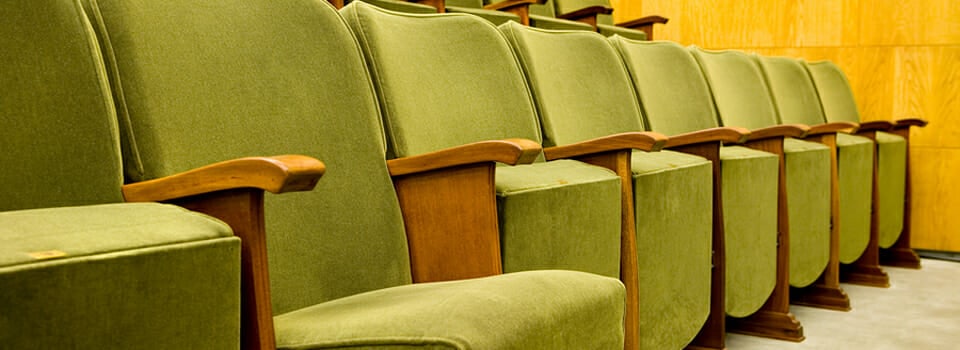Today “Church” comes in many different forms, sizes and ministry focuses. While everyone can agree that stewardship should be a guiding principle for committees making financial decisions, what does that mean practically? What should the priorities and tradeoffs be between price, quality and mission so as to maximize your church’s purpose while minimizing distractions?
Many churches have faced and successfully managed these challenges by following a systematic process that combines an honest analysis of their own unique circumstances with proven purchasing principles. This process can also help your church save on costs, reduce risks and extend the ministry impact of your furnishing purchases.
Realistically Assess Your Financial Situation
The fact of the matter is that the financial ability to fund large purchases is not necessarily related to the age or lifecycle of a church. Some new church plants have established churches or wealthy individual sponsors helping them. Others have shrinking church membership or pre-existing financial obligations that can’t be ignored. Many are facing uncertain population and income demographics and so on. Every church has a unique set of circumstances that will impact their financial capacity to make purchases. What are yours?
By starting with a realistic assessment of your available financial resources, your church can also avoid a lot of downstream conflict among decision makers and church members.
Don’t be discouraged if your budget does not meet your dream—just be realistic. There are many options for maximizing that budget once it’s defined. Remember that successful church building and purchasing projects are generally characterized by membership consensus and support. It’s better to be realistic, reach consensus and avoid the conflict that can come with negative financial surprises.
Define Ministry Purpose and Priority of Purchases
Once you have determined your church’s budget for furnishing purchases, determine what items should be purchased and their priority based upon ministry needs. Perhaps that new glass pulpit could be deferred to allow the purchase of additional seating or even substituted for a Plexiglas model. Likewise, more expensive seating could be traded for additional tables, and so on. Successful church purchasing programs are overwhelmingly ministry driven!
This is also a great opportunity to help unite your finance/building/purchasing committee members in support of the ministry your church is called to. Like financial capacity, product priority defined early will help to minimize potential conflict later.
Once armed with a realistic budget, identification of needed furnishings and their priority, you are ready to address the next important step in your purchasing quest: selecting a product provider.
Selecting a Furnishings Provider
For many years I annually surveyed the purchasing practices of 500 randomly selected churches divided into categories of Mainline, Evangelical, Charismatic/Pentecostal and Catholic, all representatives of national percentages. This work was later picked up and greatly expanded in both size and quality into a bi-annual survey of 150,000 American churches by Your Church Magazine, a national trade publication of Christianity Today Publications, where I also served on the Editorial Board for many years.
While Your Church Magazine was discontinued during the great recession, the surveys that were conducted over many years still stand as the most important and definitive information regarding American church purchasing practices ever compiled.
Over the years, one thing was clearly revealed and consistently affirmed. The churches that had the best purchasing experiences made their decisions based on three supplier and product criteria: quality, value and trust.
How to Determine the Quality of a Furnishing Provider
Today there are many providers of church furnishings and not all of them are created equally nor do business to the same standards. Your church can avoid many of the problems that can arise when dealing with the wrong product provider by following a few proven practices:
- Only buy from a well-established and reputable provider. Ask how long they’ve been in business, will they provide multiple references, have they ever filed for bankruptcy, or had a complaint filed by a church, denomination, regulatory or trade authority? What were they and how were they resolved?
- Are product warranties clearly written and easy to understand? Who will guarantee the warranty and what will the church have to do to enforce the warranty? Keep in mind that some providers will require return of the defective product before providing a new product. This produces shipping charges that cost more than replacing the product and says much about the integrity of the provider.
- Follow up and interview the references. This is an investment of several thousands of dollars and the wrong provider could cost you.
A Special Note About Seating
Seating purchases are almost always the single biggest furnishing expense incurred by a church. As such, they deserve a closer look.
Church seating generally falls into three categories for worship areas: pews, upholstered chairs or theatre seats. Over the years, we’ve observed a shift in seating choice popularity among churches. Now, more than 85% of worship area seating is stackable, upholstered chairs for the following reasons:
- Increased Seating Capacity: Research indicates the average pew user takes up 24 inches of lineal seating space. The average worship chair is 20 inches wide. This factor alone nets approximately a 20% increase in available seating in a worship application while also providing increased handicapped seating access.
- Overall Comfort: Quality worship seating contains 3.5 inches or more of virgin foam with the back pitch generally more relaxed than most pew backs, making for overall superior chair comfort.
- Multi-Use Space: Chairs allow for flexible configuration of space for a variety of uses and worship applications which can expand the utility of existing space and/or eliminate additional construction requirements and costs.
- Cost: Quality worship chairs are priced from the mid $30’s to $60’s per 20-inch seat while pews cost $65+ per linear foot (two feet required per seat) with fewer seats per application and theatre-style seating costing $150-$250 per seat.
- Add-On Seating: Chairs allow for easy expansion or reconfiguration of seating arrangements as needed.
- Attractiveness for Younger Families and First Time Church Goers: Research has established that younger families and church newcomers appreciate the appearance, comfort and flexibility of chair seating over pews and theatre-style seating.
Value, Price and Stewardship
Recently I spoke with the pastor of a large urban church that was simultaneously renovating their worship facility and building a satellite church in a nearby community.
They were looking to purchase about 1,000 new worship chairs and his committee was deadlocked between those wanting to save money by buying the least expensive chairs available and those interested in investing in a quality, long-lasting seating solution. He asked for my thoughts.
When I responded with, “this isn’t about chairs, it’s about stewardship,” he quickly agreed.
Everyone knows there’s always somewhere to get a lower price. But at some point, the trade off in price translates to a lower quality and a shorter product life and related product problems.
Because real stewardship is about obtaining the best value for your church (defined as a combination of price, product quality, warranty and service), your church should first define what they are looking for in the product related to serviceability, life span, etc. Then the church’s decision makers can select a product that meets the criteria representing their values and stewardship. Price will take care of itself.
Many reputable product providers have helpful educational brochures, website information and DVDs that can offer information to educate your decision makers so they make thoughtful decisions. Take advantage of these but be sure to ask for clarification and verification in writing for any questions you might have.
Purchasing furnishings for your church can be a joy and ministry enhancement, or it can be the beginning of an expensive nightmare and the source of argument and dissension. Many churches that have successfully navigated this tricky course have shared common practices; by following a few simple guidelines, your church can greatly increase the probability that your purchases experience will be positive and enhance your ministry.











